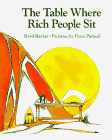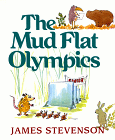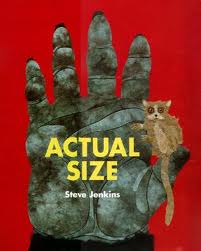Picture Books in the Math Program
This article by Carol Otis Hurst first appeared in Teaching K-8 Magazine.

Certainly there's nothing new in the idea of using picture books in the math program. Many books are being published these days with that very idea in mind. For years we've used counting books to help in making number concepts clear but, in this column, as we did in the history section, we're going to look at some less obvious choices for our math picture books.
1. Byrd Baylor and Peter Parnall's The Table Where Rich People Sit (Atheneum, 1994 ISBN 0684196530. Order Online) is my first math choice. With humor and imagination, a family explains its value system. Because they relate everything to big money while actually not valuing or working toward wealth, this makes an excellent book through which to play with large numbers and your own value system. More Information.
2. Tony Blundell's Beware of Boys (Mulberry, 1996 ISBN 0688147399. Order Online) is a variant of "Stone Soup". As a boy attempts to outwit a hungry wolf, he sets the wolf off on a series of wild goose chases, each involving ingredients for a new recipe for boy. The book is very funny but it's the measurement both dry and wet and both real and imaginary that I'm after here. More Information.
3. Two alphabet books come next in my math series. First there's Mary Elting and Jack Kent's Q Is For Duck: An Alphabet Guessing Game (Clarion, 1980 ISBN 0395300622. Order Online). Any alphabet book is a pattern book with the alphabet as pattern. Q Is for Duck is no exception. What makes it different and therefore more useful in the math program is that there's a kind of "outside the box" thinking necessary to predict the action.
4. George Shannon and Donald Crews have provided us with our second mathematical alphabet book. Tomorrow's Alphabet (Greenwillow, 1996 ISBN 0688135048. Order Online) involves absorbing the alphabet pattern and the pattern of a particular kind of prediction. "B is for eggs, tomorrow's birds" so "C is for milk, tomorrow's ?" cannot be "cow", as many people guess first, because milk doesn't turn into a cow. Absorbing a pattern and predicting the next in a sequence is done playfully and very well in this picture book.
5. Return to full story books and take a look at one that's been around a long time, Dr. Seuss's The 500 Hats of Bartholomew Cubbins (Random, 1989 ISBN 0825436184. Order Online). We know from the title that there are going to be 500 hats. Neither Bartholomew nor the King are aware of that. This insider information lets us view the action differently and we begin counting almost immediately. Because not every hat from 1 to 500 is visible to us, we are forced to count around the gaps to make the book make sense. Filling in missing information seems like math to me.

6. The Mudflat Olympics by James Stevenson (Greenwillow, 1994 ISBN 0688129234. Order Online) is replete with mathematical thoughts and activities. Short chapters detail the events in the animals' Olympics. The animals have no compunction about stretching the truth and the reader needs to exercise logic in order to see what's going on. An added mathematical dividend is the various measurement called for in the stories. More Information and Activities.
7. Too Many Pumpkins by Linda White and Megan Lloyd (Holiday House, 1996 ISBN 0823412458. Order Online) has the reader making predictions and multiplying numbers almost immediately, although it never mentions the process. When a pumpkin rolls into the yard of a pumpkin-hating woman, she buries it. Now, how many seeds are there in the average pumpkin? How many pumpkins on each vine?
8. Estimation and problem solving can be approached through Weighing the Elephant by Ting-xing Ye and Suzane Langlois (Annick, 1998 ISBN 9781550375268. Order Online). The villagers must use both those skills to accomplish the seemingly impossible task of figuring out an elephant's exact weight without access to a large scale.
9. Phyllis Naylor and Tony Maddox's Ducks Disappearing (Atheneum, 1997 ISBN 0689319029. Order Online) is a counting book with a plus. We quickly begin counting ducklings and subtracting as the line gets smaller but that's only part of the story. Soon we are presented with a problem to be solved.
10. The Button Box by Margarette S. Reid and Sarah Chamberlain (Dutton, 1990 ISBN 0525445900. Order Online) focuses on categories or attributes. It's as much scientific as it is mathematical.

New Books since this article was written
 Actual Size by Steve Jenkins. (2004, Houghton. ISBN 0618375945. Order Info.) Nonfiction Picture Book. 28 pages. Gr PreK-3.
Actual Size by Steve Jenkins. (2004, Houghton. ISBN 0618375945. Order Info.) Nonfiction Picture Book. 28 pages. Gr PreK-3.
This outstanding nonfiction title is another of many wonderful books by Steve Jenkins. His torn paper illustrations created with handmade papers are exquisite and very engaging. In this title animals or parts of animals are shown life size. The eye of a giant squid fills a page and, believe it or not, is beautifully rendered with textured papers. Read More.
Use the life size illustrations in this book to take measurements and add them, find the differences, convert to other units and other computation exercises.
Related Areas of Carol Hurst's Children's Literature Site
- Math and Children's Books. Books, articles and activities.
- Looking Critically at Picture Books with Older Readers.
- Picturing Math: Using Picture Books in the Math Curriculum, Prekindergarten through Second Grade by Carol Hurst and Rebecca Otis.
For Your Convenience You Can Order the Following Books Online
You Can Always Change Your Mind Later.
- The Table Where Rich People Sit
- Beware of Boys
- Q Is For Duck: An Alphabet Guessing Game
- Tomorrow's Alphabet
- The 500 Hats of Bartholomew Cubbins
- The Mudflat Olympics
- Too Many Pumpkins
- Weighing the Elephant
- Ducks Disappearing
- The Button Box
- Picturing Math: Using Picture Books in the Math Curriculum, Prekindergarten through Second Grade by Carol Hurst and Rebecca Otis.
Read More about our agreement with Amazon.com.
Next Section, Books in Science, of November 2000 newsletter
Advertisement:
Advertisement:
Advertisement:

